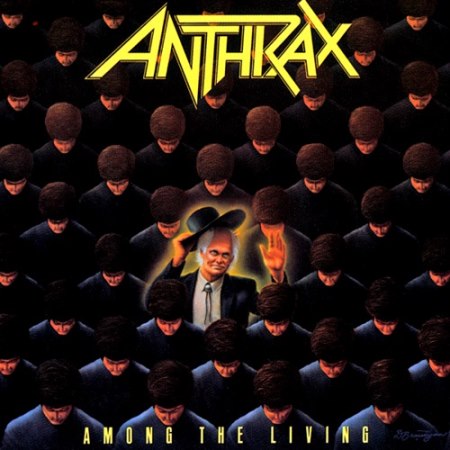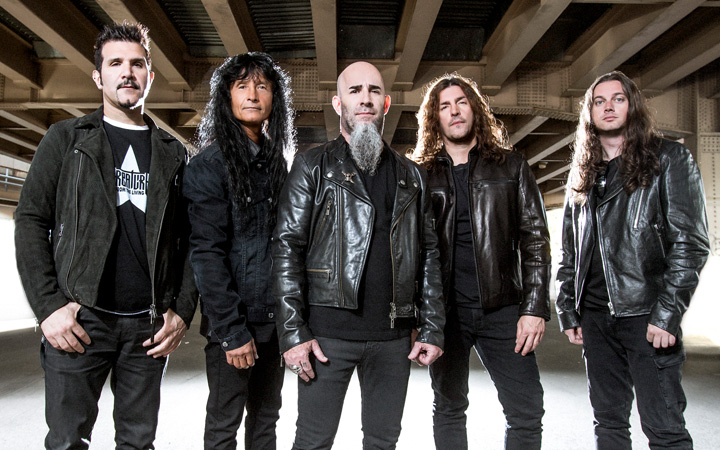When you ask Scott Ian, the founding guitarist of Anthrax, how he feels now that the band’s classic album, Among the Living, is 30 years old, he'll tell you that he finds the whole thing hard to put into words.
“It’s too big a thing to comprehend that we were doing that album 30 years ago, and this is what we’re still doing,” he told me during our phone conversation.

Anthrax - Among the Living
“If I was a pot smoker, I’d probably get into some heavy conversations about the elasticity of time. But for me, it’s weird because in some ways it feels like we did it yesterday, and in some ways it feels like it has been longer than thirty years. I was 23 when we did that album. I’m a completely different human being today.”
What’s clear to Ian after all this time is that Among was the album that broke Anthrax through to a new level and finally captured the band’s true sound — a feat that had eluded them in their previous recordings.
As longtime Anthrax drummer Charlie Benante says, “I didn’t feel like our previous album, Spreading the Disease, really represented the band that I heard in my head, where I’ve always felt Among the Living was the band I heard in my head.”
Ian agrees. “I felt like Among was the first time we sounded like the band that I would hear when we were in the rehearsal room playing the songs for ourselves, just ripping through them.”
The Making of a Thrash Classic
In the previous year, 1986, a bold new style of metal was breaking through, and the writing was on the wall that this would be the way of the future for heavy music.
Metallica released Master of Puppets, Megadeth put out Peace Sells But Who’s Buying?, and Slayer unleashed Reign in Blood. Each album took these bands to a new level in terms of their songs, production, speed, precision, and brutality.
Once the ball started rolling, the songwriting process for Among came together quickly. Some may not be aware that Charlie writes a lot of the music for Anthrax, and most of the riffs on Among are his. “Scott was always good at adding sections to a song too,” Benante adds. “He would add a riff to this, a riff to that, stuff like that.”
Ian recalled that about “15 to 20%” of the riffs on Among were his, and that the majority of the album “was predominantly a lot of Charlie’s stuff. A lot of times, I would write the bridges and lead break rhythm sections. With "Imitation of Life," I think most of that might have been my riffs because that was from an S.O.D. song that never got used.”
RELATED ARTICLE
Charlie would write songs on a cheap star–bodied guitar that Scott sold to him for $100. “I loved that guitar,” Benante says. “When I first played it, it felt like an extension of me. Mostly every Anthrax song back in the day was written on that guitar. It just had so many songs in it. Every time I played that guitar, something new came out of it.”
When jamming out tunes, Benante also doesn’t play through a typically metal amp setup, telling Guitar.com his usual amp of choice is a Vox AC30.
While Ian would endorse ESP guitars during the Among period, in the studio he primarily used his ’82 custom made Jackson Rhoads model and an ’81 Gibson Flying V, both equipped with Seymour Duncan JB pickups.
Ian’s amp setup was also very simple: ’82 Marshall JCM 800s with a TC Electronic Booster Distortion pedal that he only used as a boost to drive distortion on the amp. Benante used the same model TC Booster when playing and writing new songs, as well.
Dan Spitz, who was Anthrax’s lead guitarist for many years, would play custom built Jackson Randy Rhoads model guitars that had comic book graphics painted on the body. Because Spitz was short, the guitars were built quarter–size to fit him better. Spitz would use EMG pickups and play through Mesa Boogies.
In later years, Ian would have his own signature model Randall amp, and he would sometimes play Bogner gear. But the most important key to great thrash guitar playing, more important than any piece of equipment, is the right hand.
It's like fascistic guitar playing. There is no room for any space or error. For us, the rhythm was supposed to sound like a machine gun drilling into your head." - Scott Ian
As Ian told Guitar World, “I think the key is my right hand; specifically, the way I pick. I lean in really heavy… You’ve gotta dig in to get that edge. I can play through any setup with some kind of gain and master volume, and it will sound like me because of my right hand.”
Ian, like many great thrash riff masters, also relied heavily on down–picking, which makes the rhythms tighter and easier to double–track in the studio.
“If each note is rigidly down–stroked perfectly in time, you can match it perfectly,” Ian says. “It's like fascistic guitar playing. There is no room for any space or error. For us, the rhythm was supposed to sound like a machine gun drilling into your head.”
It also should be mentioned that usually on thrash albums the rhythm guitarists would play all the riffs, and players like Spitz and Metallica’s Kirk Hammett would just provide the solos, because again, one guitarist laying down the rhythms makes it sound much tighter.
Among the Recording
Among was recorded at Quadradial Studios album in Miami (with the legendary Eddie Kramer producing), and it was mixed at Compass Point Studios in the Bahamas, where Iron Maiden mixed their albums.
“We were losing our minds,” Ian says. “We couldn’t believe the shit we were doing and what was happening. All of that energy, you can really feel it in those songs, how excited we were.”
Kramer, of course, had previously produced many legendary artists, including Hendrix, Zeppelin, and Kiss. It was a big honor for the band to work with Kramer, and as Benante says, “The big thing for me was getting Eddie to do the record. He did some of my favorite records before that, and sitting with him, watching him, it was an experience I’ll never forget. And to this day, what he brought to the record completely helped us achieve our goals.”
Anthrax - "Indians" (Official Video)
Ian says, “We wanted to work with Eddie Kramer because with all the bands he recorded in the '70s, those albums sounded like how you’d imagine those bands would sound if you were standing in the same room with them.”
Which isn’t to say that the process didn’t have any bumps in the road. Kramer wanted to make a modern–sounding album — at least by 1987 standards — and Mutt Lange’s production for Def Leppard was considered cutting edge for the time, an approach that was completely wrong for Anthrax.
The first mix for Among was overloaded with reverb, and Ian insisted it be removed. In fact, with the Master of Puppets and Reign in Blood albums, Metallica and Slayer recorded without reverb as well.
“We just wanted it really dry,” Benante says. “We wanted the tightness and the power to be there. We didn’t want the power or the atmosphere to be from some fake reverb, we wanted it to come from the room, and let that be the vibe of the record.”
It was a tough record for me. I’d never recorded anything quite like it. It was a challenge to figure out ways to record heavy guitars with heavy drums — it was just a different process." - Eddie Kramer
“Our sound just made more sense to have it in your face,” Ian says. “Our attitude was that we wanted to capture what we heard in the rehearsal room, and what we heard when we played on stage. We went drastically all–the–way dry with the mix at first because the first rough mix that Eddie did for us sounded like Pyromania, and that wasn’t gonna work for us.”
Kramer admitted to Music Radar, “It was a tough record for me. I’d never recorded anything quite like it. It was a challenge to figure out ways to record heavy guitars with heavy drums — it was just a different process… I remember it being contentious during the mixing. It took me a while to figure out what they were looking for, but once I did, it all turned out incredibly well.”
And indeed, thrash metal was a brave new world musically, which required a much different production approach than a standard rock album.
RELATED ARTICLE
Ian says, “There were so many new things in the music. The dense rhythm guitar tones that are eating up so much of the frequency spectrum. You have to balance that and still have the bass cut through.
”The sonic mechanics of songs going 180, 190, 200 beats per minute, double kicks being played at that speed, making sure your left and right kick drums were at the same level. Making sure the snare drum cuts through. Sometimes when you’re playing faster and hitting the snare at such speeds, they’re not going to be hitting as hard if they’re playing that fast.
”There were no Pro Tools yet, there were no computers involved. It was all done by ear.”
Anthrax Ascends
I often ask bands if they knew they had the goods before they release an album. Benante says, “We definitely felt strongly about this record. Half of that record had hits on it, if you know what I mean. I don’t mean radio hits, I just mean some of the songs that were on that record have been in the set since they’ve been released. Some of those songs we can never not play live.”
Ian says, “I’d like to say we knew we had Sgt Peppers, but it’s not that simple (laughs). We knew we had good material because we were already playing "Indians" and "I Am the Law" live before we recorded the album. We certainly knew those two songs were really good, and we felt we had a lot of other really good material as well.
“We’d gotten better as songwriters. It was our third album, but it was our first one written as the actual band because Joey joined on Spreading, but that album was already written when he joined, so Among was the first album written as that unit — the first album written as the band that became Anthrax — and it just really shows.”

Anthrax (Photo by Jimmy Hubbard)
Thirty years later, Among the Living has passed the most crucial test, the test of time. The band recently did a run in Europe where they played the entire album live, and Ian says, “It all went over great. It feels as new as it did 30 years ago. There’s songs from that album that have never been out of the set. It all holds. I don’t get bored playing those songs.”
Benante has often said that Among the Living was the album that gave Anthrax their career, and as Ian confirms, “Among broke the band. We started that tour playing to roughly 500 people in May ’87, and by December, there were 6,000 to 7,000 people showing up to shows.
“It was incredible. The wave that we were a part of with the other big four bands really broke in a big way, and we wrote a great album. We wrote the right songs at the right time.”


